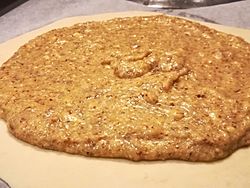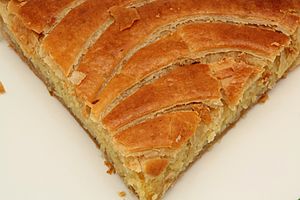Frangipane facts for kids

Frangipane cream before baking
|
|
| Type | Custard |
|---|---|
| Main ingredients | Almonds or almond flavouring, butter, sugar, eggs |
Frangipane (pronounced FRAN-jih-payn) is a super yummy, sweet cream that tastes like almonds! People use it to fill all sorts of delicious cakes and pastries. Think of it as a special kind of custard that makes treats like the Bakewell tart or conversation tart extra special. It's also found in French pastries like the Jésuite and pithivier.
This tasty filling has been around for a long time. The word "franchipane" appeared in a French cookbook in 1674. Later, in 1732, a dictionary for bakers used the modern spelling, "frangipane." At first, it was a custard tart with almonds or pistachios. Over time, it became a filling that could be used in many different baked goods.
Contents
How Frangipane is Made
Frangipane is usually made by mixing two different creams. You combine two parts of "almond cream" with one part of "pastry cream."
Almond Cream
Almond cream is made from a few simple ingredients. These include butter, sugar, eggs, and ground almonds (called almond meal). Sometimes, a little bread flour and rum are added too.
Pastry Cream
Pastry cream is a smooth, thick cream. It is made with whole milk, vanilla, cornstarch, sugar, and egg yolks (or whole eggs). A little butter is often added at the end to make it extra creamy.
There are many ways to make these creams. Bakers also change how much almond cream and pastry cream they mix together. This creates different kinds of frangipane.
A Sweet Story
Some old stories say that a kind of almond sweet was brought to Saint Francis of Assisi in 1226. This happened when he was very ill and dying. This "almond sweet" might have been an early version of frangipane. It could also have been a Roman sweet called mustacciuoli.
The King Cake Tradition
Frangipane is a very important part of a French tradition. On Epiphany, which is a holiday in January, French families eat a special cake. This cake is called the king cake (or galette des rois). It is a round cake with layers of frangipane inside.
Finding the Bean
Before serving, a small bean or a tiny figurine is hidden inside the cake. The cake is cut into slices. A child, often called le petit roi (the little king), usually hides under the dining table. They tell everyone who gets which slice of cake. Whoever finds the bean in their piece of frangipane cake gets to be "king" or "queen" for the day! They often wear a paper crown.
Etymology
The name "frangipane" comes from Italian. It is believed to be named after a noble family, the Frangipani family. Some say it was named after Marquis Muzio Frangipani or Cesare Frangipani.
Perfume Connection
The word "frangipani" first referred to a plant with beautiful, sweet-smelling flowers. A perfume was made from these flowers. This perfume was originally thought to be what flavored the frangipane cream.
Other stories say that the name was a tribute to a different Frangipani. In the 16th century, Parisian chefs named the almond custard after him. This was because he created a jasmine-based perfume. This perfume smelled like the flowers and was used to scent leather gloves. Some popular stories even claim that an Italian nobleman invented the dish himself. This happened while he was visiting the court of Louis XIII in France.
See also
 In Spanish: Frangipane para niños
In Spanish: Frangipane para niños


